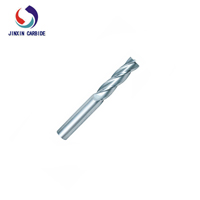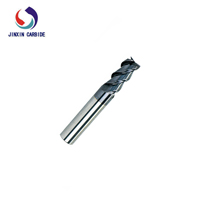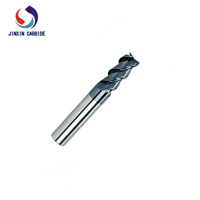-

-
PRODUCTS

-
SERVICE SUPPORT

31
2023
-
10
Characteristics of end mills
End mills come in several shapes and many sizes. Coatings can also be selected, as well as helix angle and number of cutting faces.
Shapes: Several standard shapes of milling cutters are used in industry today, which are explained in more detail below.
Flutes/Blades: The flutes of the milling head are deep spiral grooves that run along the cutter, and the sharp blades along the edges of the flutes are called flutes. The blade cuts the material and chips of that material are pushed out of the flute through the rotating drill bit. There is almost always one cutting edge per flute, but some cutters have two cutting edges per flute. [1] Often, flutes and cutting edges are used interchangeably. Milling cutters may have one or more cutting edges, with 2-, 3-, and 4-edge being the most common. Generally, the more teeth a blade has, the faster it can remove material. Therefore, a 4-tooth cutter can remove material twice as fast as a 2-tooth cutting tool.
Helix angle: The flutes of a milling cutter are almost always helical. If the flute is straight, the entire blade will impact the material immediately, causing vibration and reducing accuracy and surface quality. Setting the flute at an angle allows the cutting edge to gradually enter the material and reduce vibration. Typically, finishing tools have higher helix angles for better machining.
Center cutting: Some milling cutters can drill straight down through the material, but most milling cutters cannot. This is because the cutting edge of the tool cannot reach all the way to the center of the terminal. However, these knives can cut downward at an angle of around 45 degrees.
Roughing or finishing: Different types of milling cutters can be used to cut large amounts of material, leaving a poor surface smoothness (roughing), or remove smaller amounts of material, but leave a good surface smoothness (finishing). Roughing tools may have serrated teeth for breaking scraps of material into smaller pieces. These blades leave a rough surface. Finishing tools can have a large number (4 or more) of cutting edges and are used to carefully remove material. However, large amounts of flutes leave little room for effective chip removal, making them less suitable for removing large amounts of material.
Coatings: The right tool coating can have a big impact on the cutting process by increasing cutting speed and tool life, as well as improving surface finish. Synthetic diamond (PCD) is a special hard coating used on cutting tools that must withstand high levels of wear. PCD coated tools can last up to 100 times longer than uncoated tools. However, the coating cannot be used at temperatures above 600 degrees Celsius or on ferrous metals. Aluminum machining tools are sometimes coated with titanium aluminum nitride. Aluminum is a relatively sticky metal and can weld itself to the teeth of tools, making them appear dull. However, it tends not to adhere to TiAlN, allowing the tool to be used in aluminum for longer periods of time.
Shank: The shank is the cylindrical (non-fluted) part of the tool that is used to secure and position it in the tool holder. The shank can be completely round and held in place by friction, or it can have welded flats where set screws also called headless screws make contact without tool slippage to increase torque. The diameter may be different from the diameter of the cutting part of the tool and therefore may be held by a standard tool clamp.
Related news






